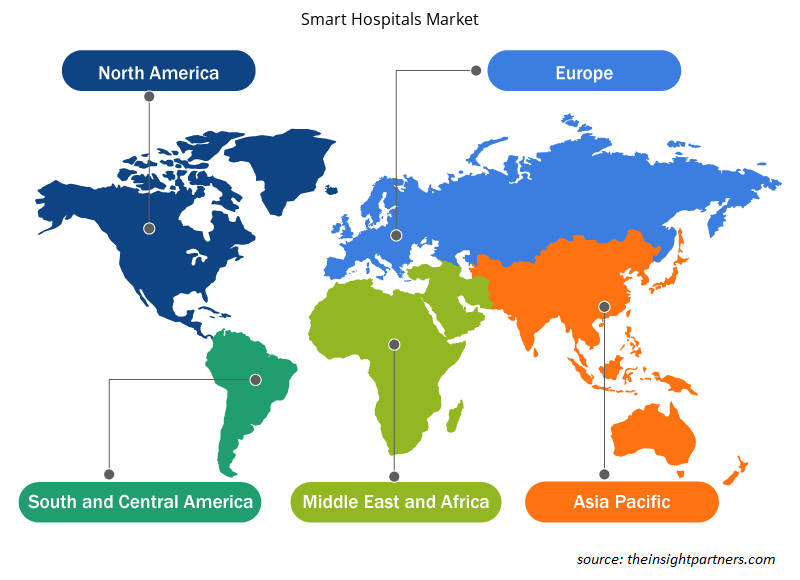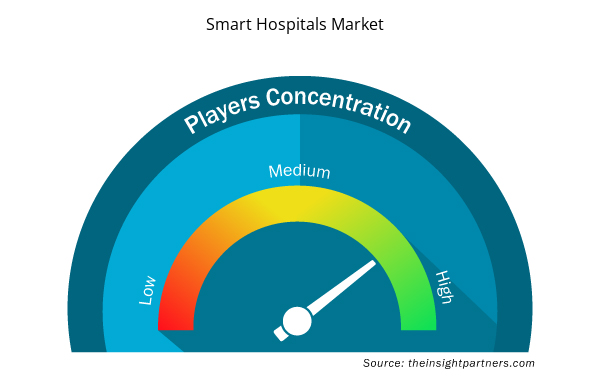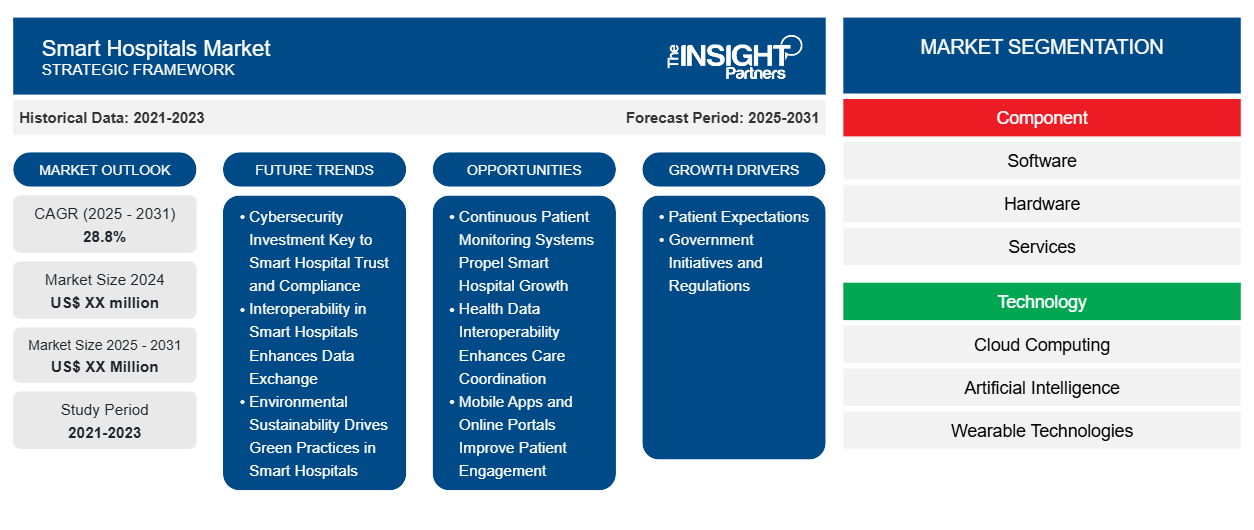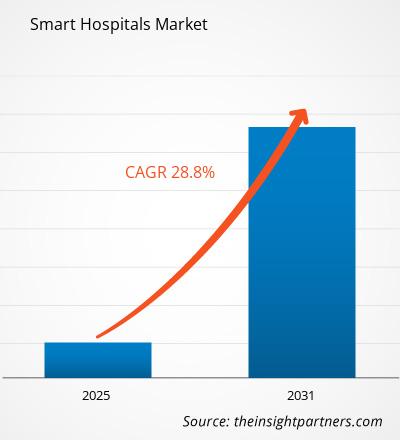Se espera que el mercado de hospitales inteligentes registre una CAGR del 28,8 % entre 2024 y 2031, con un tamaño de mercado que se expandirá de US$ XX millones en 2024 a US$ XX millones en 2031.CAGR of 28.8% from 2024 to 2031, with a market size expanding from US$ XX million in 2024 to US$ XX Million by 2031.
El informe del mercado de hospitales inteligentes cubre el análisis por componente, tecnología, aplicación, conectividad y geografía.
Propósito del Informe
El informe Smart Hospitals Market de The Insight Partners tiene como objetivo describir el panorama actual y el crecimiento futuro, los principales factores impulsores, los desafíos y las oportunidades. Esto proporcionará información a diversas partes interesadas del negocio, como:
- Proveedores/fabricantes de tecnología: Para comprender la dinámica cambiante del mercado y conocer las oportunidades potenciales de crecimiento, lo que les permitirá tomar decisiones estratégicas informadas.
- Inversionistas: Realizar un análisis exhaustivo de tendencias sobre la tasa de crecimiento del mercado, las proyecciones financieras del mercado y las oportunidades que existen en toda la cadena de valor.
- Órganos reguladores: Regular las políticas y vigilar las actividades del mercado con el objetivo de minimizar los abusos, preservar la confianza de los inversores y defender la integridad y la estabilidad del mercado.
Segmentación del mercado de hospitales inteligentes
Componente
- Software
- Hardware
- Servicios
Tecnología
- Computación en la nube
- Inteligencia artificial
- Tecnologías portátiles
- Identificación de frecuencias de radio
- Otros
Solicitud
- Gestión remota de medicamentos
- Imágenes médicas conectadas
- Asistencia médica
- Historial médico electrónico y flujo de trabajo clínico
- Vigilancia ambulatoria
Conectividad
- Cableado
- Inalámbrico
Personalice este informe según sus necesidades
Obtendrá personalización en cualquier informe, sin cargo, incluidas partes de este informe o análisis a nivel de país, paquete de datos de Excel, así como también grandes ofertas y descuentos para empresas emergentes y universidades.
- Obtenga las principales tendencias clave del mercado de este informe.Esta muestra GRATUITA incluirá análisis de datos, desde tendencias del mercado hasta estimaciones y pronósticos.
Factores impulsores del crecimiento del mercado de hospitales inteligentes
- Expectativas de los pacientes: la aparición de altas expectativas por parte de los pacientes en cuanto a una atención personalizada y de calidad exige la creación de hospitales inteligentes que satisfagan las nuevas demandas. Este cambio está contribuyendo a un crecimiento masivo del mercado, ya que el mercado internacional muestra un aumento de las inversiones para promover la participación de los pacientes. Los análisis de mercado indican que los hospitales que adopten estas tecnologías inteligentes ocuparán una mayor cuota de mercado, lo que mejorará la innovación en la prestación de servicios y la atención sanitaria en general.
- Iniciativas y regulaciones gubernamentales: Las iniciativas gubernamentales y los marcos regulatorios que fomentan la innovación en el cuidado de la salud son fundamentales para impulsar el mercado de los hospitales inteligentes. Las políticas que mejorarían la eficiencia de la atención médica y mejorarían los resultados de los pacientes son probablemente lo que alentaría a los inversores en tecnologías inteligentes. Es por eso que el panorama del mercado para el segmento de mercado será más optimista, con una perspectiva de crecimiento impulsada por regulaciones positivas. Las tendencias de crecimiento se experimentarán a medida que la industria global reaccione con una mayor participación de mercado a través de empresas que inviertan en soluciones de salud digital, como se refleja en los informes de mercado recientes y los análisis de tendencias de la industria.
Tendencias futuras del mercado de hospitales inteligentes
- La inversión en ciberseguridad es clave para la confianza y el cumplimiento normativo de los hospitales inteligentes: con la creciente digitalización de los hospitales inteligentes, la ciberseguridad ha pasado a ser el centro de atención. La protección de los datos confidenciales de los pacientes siempre ha sido muy importante, por lo que los proveedores de atención médica han invertido más en medidas de ciberseguridad sólidas. Esto crea un margen para las empresas que pueden ofrecer soluciones en el ámbito de la ciberseguridad y entablar colaboraciones con los proveedores de atención médica. A medida que la estrategia del mercado cambia hacia protocolos de seguridad holísticos, esto es muy importante para mantener la confianza de los pacientes y su cumplimiento normativo. Esta tendencia constituye la columna vertebral de un sistema de hospital inteligente resistente a las amenazas cibernéticas.
- La interoperabilidad en los hospitales inteligentes mejora el intercambio de datos: la interoperabilidad en los hospitales inteligentes está ganando fuerza a medida que los sistemas de salud continúan su búsqueda del intercambio de datos sin complicaciones. La nueva tendencia promueve la interoperabilidad y mejora los resultados de los pacientes entre los proveedores de atención médica. Según el análisis PEST, las presiones regulatorias sobre los formatos estandarizados de datos han impulsado la innovación. Los actores clave han estado trabajando en estrategias de mercado ideando soluciones interoperables que permitirían un mejor intercambio de datos, influyendo así positivamente en la dinámica del mercado y garantizando que se observe una atención adecuada al paciente.
- La sostenibilidad medioambiental impulsa las prácticas ecológicas en los hospitales inteligentes: la conciencia de la sostenibilidad medioambiental está obligando a los hospitales inteligentes a adoptar prácticas respetuosas con el medio ambiente. Esto incluye infraestructuras energéticamente eficientes y programas de reducción de residuos, que poco a poco se están convirtiendo en una parte integral del funcionamiento del hospital. Un análisis PEST llama la atención sobre el marco legal vigente para la búsqueda de la sostenibilidad en la atención sanitaria. Las tendencias generales del mercado están recibiendo de hecho implicaciones positivas de los principales actores basados en las estrategias de mercado centradas en las tecnologías ecológicas y las prácticas sostenibles. En relación con esto, los hospitales inteligentes no solo mejoran su rendimiento como unidades operativas, sino que también mantienen la imagen pública y la satisfacción del paciente.
Oportunidades de mercado en hospitales inteligentes
- Los sistemas de monitorización continua de pacientes impulsan el crecimiento de los hospitales inteligentes: el sistema de monitorización continua de pacientes representa un área de crecimiento importante para los hospitales inteligentes. Es por ello que un análisis competitivo indica que los hospitales con sede en Norteamérica que inviertan en estas tecnologías estarán en una buena posición para destacarse en el panorama de la industria, ya que cumplirán con las expectativas crecientes en cuanto a la gestión proactiva de la atención sanitaria.
- La interoperabilidad de los datos sanitarios mejora la coordinación de la atención: la necesidad de interoperabilidad de los datos sanitarios está creando una oportunidad saludable para los hospitales inteligentes en áreas de crecimiento. Los sistemas interoperables garantizarán que la información se comparta sin problemas entre los proveedores y, a su vez, mejorarán la coordinación y los resultados de la atención. Esta iniciativa es especialmente necesaria en América del Norte porque sus sistemas sanitarios fragmentaron a los pacientes y han creado problemas a la hora de gestionarlos.
- Las aplicaciones móviles y los portales en línea mejoran la participación de los pacientes: con las aplicaciones móviles y los portales en línea, los pacientes pueden gestionar mejor su experiencia de salud. Esto también es fundamental en el sector norteamericano, donde las preferencias de los pacientes cambian continuamente de una atención sanitaria basada en experiencias menos interactivas a una experiencia más interactiva. Un análisis competitivo detallado muestra que los hospitales "orientados a la participación de los pacientes" pueden distinguirse en el sector de la atención sanitaria, que resulta ser relativamente más impresionante en términos de satisfacción de los pacientes y, por lo tanto, de fidelización a largo plazo entre ellos.
Perspectivas regionales del mercado de hospitales inteligentes
Los analistas de Insight Partners explicaron en detalle las tendencias y los factores regionales que influyen en el mercado de hospitales inteligentes durante el período de pronóstico. Esta sección también analiza los segmentos y la geografía del mercado de hospitales inteligentes en América del Norte, Europa, Asia Pacífico, Oriente Medio y África, y América del Sur y Central.

- Obtenga datos regionales específicos para el mercado de hospitales inteligentes
Alcance del informe de mercado de hospitales inteligentes
| Atributo del informe | Detalles |
|---|---|
| Tamaño del mercado en 2024 | XX millones de dólares estadounidenses |
| Tamaño del mercado en 2031 | US$ XX millones |
| Tasa de crecimiento anual compuesta (CAGR) global (2025-2031) | 28,8% |
| Datos históricos | 2021-2023 |
| Período de pronóstico | 2025-2031 |
| Segmentos cubiertos | Por componente
|
| Regiones y países cubiertos | América del norte
|
| Líderes del mercado y perfiles de empresas clave |
|
Densidad de actores del mercado de hospitales inteligentes: comprensión de su impacto en la dinámica empresarial
El mercado de hospitales inteligentes está creciendo rápidamente, impulsado por la creciente demanda de los usuarios finales debido a factores como la evolución de las preferencias de los consumidores, los avances tecnológicos y una mayor conciencia de los beneficios del producto. A medida que aumenta la demanda, las empresas amplían sus ofertas, innovan para satisfacer las necesidades de los consumidores y aprovechan las tendencias emergentes, lo que impulsa aún más el crecimiento del mercado.
La densidad de actores del mercado se refiere a la distribución de las empresas o firmas que operan dentro de un mercado o industria en particular. Indica cuántos competidores (actores del mercado) están presentes en un espacio de mercado determinado en relación con su tamaño o valor total de mercado.
Las principales empresas que operan en el mercado de hospitales inteligentes son:
- Atención sanitaria Stanley
- Tecnologías Qualcomm, Inc.
- Philips NV, la línea Koninklijke
- Allscripts Salud, LLC
- Corporación McKesson
Descargo de responsabilidad : Las empresas enumeradas anteriormente no están clasificadas en ningún orden particular.

- Obtenga una descripción general de los principales actores clave del mercado de hospitales inteligentes
Puntos de venta clave
- Cobertura integral: el informe cubre de manera integral el análisis de productos, servicios, tipos y usuarios finales del mercado de hospitales inteligentes, proporcionando un panorama holístico.
- Análisis de expertos: el informe se compila sobre la base de un profundo conocimiento de expertos y analistas de la industria.
- Información actualizada: El informe asegura relevancia comercial debido a su cobertura de información reciente y tendencias de datos.
- Opciones de personalización: este informe se puede personalizar para satisfacer los requisitos específicos del cliente y adaptarse adecuadamente a las estrategias comerciales.
Por lo tanto, el informe de investigación sobre el mercado de hospitales inteligentes puede ayudar a abrir camino para descifrar y comprender el escenario de la industria y las perspectivas de crecimiento. Si bien puede haber algunas preocupaciones válidas, los beneficios generales de este informe tienden a superar las desventajas.
- Análisis histórico (2 años), año base, pronóstico (7 años) con CAGR
- Análisis PEST y FODA
- Tamaño del mercado Valor/volumen: global, regional, nacional
- Industria y panorama competitivo
- Conjunto de datos de Excel


- GMP Cytokines Market
- Skin Tightening Market
- Advanced Planning and Scheduling Software Market
- Hot Melt Adhesives Market
- Lymphedema Treatment Market
- Health Economics and Outcome Research (HEOR) Services Market
- Smart Mining Market
- Saudi Arabia Drywall Panels Market
- Surgical Gowns Market
- Carbon Fiber Market

Report Coverage
Revenue forecast, Company Analysis, Industry landscape, Growth factors, and Trends

Segment Covered
This text is related
to segments covered.

Regional Scope
North America, Europe, Asia Pacific, Middle East & Africa, South & Central America

Country Scope
This text is related
to country scope.
Preguntas frecuentes
Some of the customization options available based on request are additional 3-5 company profiles and country-specific analysis of 3-5 countries of your choice. Customizations are to be requested/discussed before making final order confirmation, as our team would review the same and check the feasibility.
The report can be delivered in PDF/PPT format; we can also share excel dataset based on the request.
Key companies in this market are: Stanley Healthcare, Qualcomm Technologies Inc, Koninklijke Philips N V, Allscripts Healthcare LLC, McKesson Corporation, Cerner Corporation, Honeywell International Inc, GE Healthcare, SAP SE
The Smart Hospitals Market is expected to register a CAGR of 28.8% from 2023-2031.
Key future trends in this market are - Integration of IoT technologies, Growth in patient-centered care, Adoption of AI-driven solutions
The major factors impacting the Smart Hospitals Market are: Regulatory Support, Increasing Patient Demand, and Technological Advancements
Trends and growth analysis reports related to Technology, Media and Telecommunications : READ MORE..
1. Stanley Healthcare
2. Qualcomm Technologies, Inc.
3. Koninklijke Philips N.V.
4. Allscripts Healthcare, LLC
5. McKesson Corporation
6. Cerner Corporation
7. Honeywell International Inc.
8. GE Healthcare
9. SAP SE
10. Cognizant
11. Medtronic
12. Honeywell Life Care Solutions
13. Microsoft
14. Diabetizer
15. Proteus Digital Health
16. AdhereTECH
17. PhysIQ
18. IQVIA
19. Wipro Limited
20. SCIOInspire, Corp
The Insight Partners performs research in 4 major stages: Data Collection & Secondary Research, Primary Research, Data Analysis and Data Triangulation & Final Review.
- Data Collection and Secondary Research:
As a market research and consulting firm operating from a decade, we have published and advised several client across the globe. First step for any study will start with an assessment of currently available data and insights from existing reports. Further, historical and current market information is collected from Investor Presentations, Annual Reports, SEC Filings, etc., and other information related to company’s performance and market positioning are gathered from Paid Databases (Factiva, Hoovers, and Reuters) and various other publications available in public domain.
Several associations trade associates, technical forums, institutes, societies and organization are accessed to gain technical as well as market related insights through their publications such as research papers, blogs and press releases related to the studies are referred to get cues about the market. Further, white papers, journals, magazines, and other news articles published in last 3 years are scrutinized and analyzed to understand the current market trends.
- Primary Research:
The primarily interview analysis comprise of data obtained from industry participants interview and answers to survey questions gathered by in-house primary team.
For primary research, interviews are conducted with industry experts/CEOs/Marketing Managers/VPs/Subject Matter Experts from both demand and supply side to get a 360-degree view of the market. The primary team conducts several interviews based on the complexity of the markets to understand the various market trends and dynamics which makes research more credible and precise.
A typical research interview fulfils the following functions:
- Provides first-hand information on the market size, market trends, growth trends, competitive landscape, and outlook
- Validates and strengthens in-house secondary research findings
- Develops the analysis team’s expertise and market understanding
Primary research involves email interactions and telephone interviews for each market, category, segment, and sub-segment across geographies. The participants who typically take part in such a process include, but are not limited to:
- Industry participants: VPs, business development managers, market intelligence managers and national sales managers
- Outside experts: Valuation experts, research analysts and key opinion leaders specializing in the electronics and semiconductor industry.
Below is the breakup of our primary respondents by company, designation, and region:

Once we receive the confirmation from primary research sources or primary respondents, we finalize the base year market estimation and forecast the data as per the macroeconomic and microeconomic factors assessed during data collection.
- Data Analysis:
Once data is validated through both secondary as well as primary respondents, we finalize the market estimations by hypothesis formulation and factor analysis at regional and country level.
- Macro-Economic Factor Analysis:
We analyse macroeconomic indicators such the gross domestic product (GDP), increase in the demand for goods and services across industries, technological advancement, regional economic growth, governmental policies, the influence of COVID-19, PEST analysis, and other aspects. This analysis aids in setting benchmarks for various nations/regions and approximating market splits. Additionally, the general trend of the aforementioned components aid in determining the market's development possibilities.
- Country Level Data:
Various factors that are especially aligned to the country are taken into account to determine the market size for a certain area and country, including the presence of vendors, such as headquarters and offices, the country's GDP, demand patterns, and industry growth. To comprehend the market dynamics for the nation, a number of growth variables, inhibitors, application areas, and current market trends are researched. The aforementioned elements aid in determining the country's overall market's growth potential.
- Company Profile:
The “Table of Contents” is formulated by listing and analyzing more than 25 - 30 companies operating in the market ecosystem across geographies. However, we profile only 10 companies as a standard practice in our syndicate reports. These 10 companies comprise leading, emerging, and regional players. Nonetheless, our analysis is not restricted to the 10 listed companies, we also analyze other companies present in the market to develop a holistic view and understand the prevailing trends. The “Company Profiles” section in the report covers key facts, business description, products & services, financial information, SWOT analysis, and key developments. The financial information presented is extracted from the annual reports and official documents of the publicly listed companies. Upon collecting the information for the sections of respective companies, we verify them via various primary sources and then compile the data in respective company profiles. The company level information helps us in deriving the base number as well as in forecasting the market size.
- Developing Base Number:
Aggregation of sales statistics (2020-2022) and macro-economic factor, and other secondary and primary research insights are utilized to arrive at base number and related market shares for 2022. The data gaps are identified in this step and relevant market data is analyzed, collected from paid primary interviews or databases. On finalizing the base year market size, forecasts are developed on the basis of macro-economic, industry and market growth factors and company level analysis.
- Data Triangulation and Final Review:
The market findings and base year market size calculations are validated from supply as well as demand side. Demand side validations are based on macro-economic factor analysis and benchmarks for respective regions and countries. In case of supply side validations, revenues of major companies are estimated (in case not available) based on industry benchmark, approximate number of employees, product portfolio, and primary interviews revenues are gathered. Further revenue from target product/service segment is assessed to avoid overshooting of market statistics. In case of heavy deviations between supply and demand side values, all thes steps are repeated to achieve synchronization.
We follow an iterative model, wherein we share our research findings with Subject Matter Experts (SME’s) and Key Opinion Leaders (KOLs) until consensus view of the market is not formulated – this model negates any drastic deviation in the opinions of experts. Only validated and universally acceptable research findings are quoted in our reports.
We have important check points that we use to validate our research findings – which we call – data triangulation, where we validate the information, we generate from secondary sources with primary interviews and then we re-validate with our internal data bases and Subject matter experts. This comprehensive model enables us to deliver high quality, reliable data in shortest possible time.


 Obtenga una muestra gratuita de este informe
Obtenga una muestra gratuita de este informe